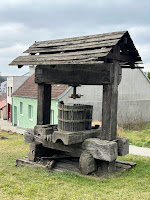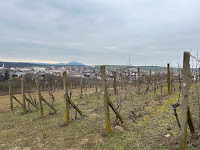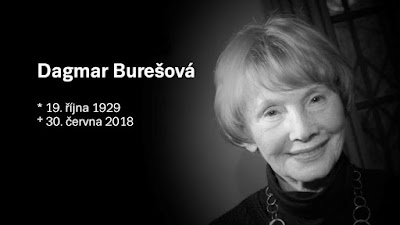 Kája's birthday was three week ago but we've been busy with work so we decided to celebrate later. I surprised him with a wellness weekend in Hustopeče.
Kája's birthday was three week ago but we've been busy with work so we decided to celebrate later. I surprised him with a wellness weekend in Hustopeče.

Hustopeče is a town about 30 km (~19 miles) southeast of Brno, located between Brno and
Břeclav. It is home to about 6.000 people and it is known for almonds and wine.
 The area was settled by Germans in the 13th century who called it Auspitz and its first mention was in 1247. The Germans brought viticulture to the area. From the start of the 14th century to 1599, Hustopeče was owned by St. Thomas's Abbey in Brno.
The area was settled by Germans in the 13th century who called it Auspitz and its first mention was in 1247. The Germans brought viticulture to the area. From the start of the 14th century to 1599, Hustopeče was owned by St. Thomas's Abbey in Brno.
 In 1572, Hustopeče was given town status by the Holy Roman Emperor Maximilian II. It belonged to the House of Liechtenstein from 1599 to 1848. In the mid-18th century, Hustopeče was Moravia's largest wine-growing municipality.
In 1572, Hustopeče was given town status by the Holy Roman Emperor Maximilian II. It belonged to the House of Liechtenstein from 1599 to 1848. In the mid-18th century, Hustopeče was Moravia's largest wine-growing municipality.
Following WWI, and the end of the Austro-Hungarian Empire, the area became part of the newly independent Czechoslovakia. After the 1938 Munich Agreement, which gave the Sudetenland to Germany, the Nazis took over. It then became part of the Protectorate of Bohemia and Moravia.
 The 1910 census indicated that most of the town's inhabitants were ethnic Germans. After WWII, the German-speaking population, even those who lived here prior to the Nazis, were expelled due to the Beneš decrees.
The 1910 census indicated that most of the town's inhabitants were ethnic Germans. After WWII, the German-speaking population, even those who lived here prior to the Nazis, were expelled due to the Beneš decrees.

Almond growing is not that common in
Central Europe. It dates back to the 17th century. In an effort to supplement food during Communism, the first large-scale orchards were planted in 1949.

A lot of the almonds goes to making mandlovice (almond brandy). The almond version of slivovice.

There are three versions - normal, coffee-flavoured, and cherry-flavoured. The original mandlovice is my favourite of all of the Czech "-ovices", followed by merunkovice, hruškovice, slivovice, and jablkovice (Calvados).
 The town's main landmark is the Church of Saints Wenceslaus and Agnes of Bohemia. The church was built in 1994 on the site of the original church that dated back to the early 14th century.
The town's main landmark is the Church of Saints Wenceslaus and Agnes of Bohemia. The church was built in 1994 on the site of the original church that dated back to the early 14th century.

The Baroque plague column dates back to 1736.

The Žumberák fountain dates back to 1595. It used to be one of the town's few sources of drinking water.
 |
| Town Hall |
The Neo-Renaissance town hall was built in 1906.
 |
| Dům U Synků |
The Dům U Synků is a Renaissance house dating back to 1579. It was renovated in 2001and today the building is used for cultural purposes. It is home to the City Museum and a Gallery.

The House of Lords of Vizovice was built from 1488 to 1492. It was renovated in 2002.

At Calvary Hill is the Chapel of St. Rocha that was built in the 17th century during a plague epidemic. It sits in a park overlooking the town.
 T.G. Masaryk
T.G. Masaryk, the first president of Czechoslovakia lived in Hustopeče from 1861 to 1868. There is a 2 km (1.25 mile) trail that can be followed to see places associated with the family.

His parents are buried in the town cemetery.

Near the town cemetery is the Red Army cemetery. There are 101 individual graves and a total of 1.875 Soviet soldiers buried here. Renovations that took place in 2005 were financed by
Russia.

The earliest known Jewish community in Hustopeče was during the 15th century. The Jewish cemetery dates back to 1886 with the last known burial taking place prior to 1942. During the German occupation the cemetery was vandalised, and later
the Communists removed all of the gravestones in the 1980s. Now there is just a memorial plaque for the town's Jewish population that perished during the Holocaust.

The train from Brno to Hustopeče takes 45 minutes and we arrived at our hotel on Friday evening. I booked us in at
Hotel Amande and really enjoyed our stay.

The hotel restaurant was excellent and on Saturday we had the full wellness experience complete with a private relaxation room and massages.

I hear that from the second half of March to the beginning of April, the almond orchards are covered with pink flowers. I'm sure that its beautiful and we'll need to make a return trip to visit some of the local wine cellars.

 The area was settled by Germans in the 13th century who called it Auspitz and its first mention was in 1247. The Germans brought viticulture to the area. From the start of the 14th century to 1599, Hustopeče was owned by St. Thomas's Abbey in Brno.
The area was settled by Germans in the 13th century who called it Auspitz and its first mention was in 1247. The Germans brought viticulture to the area. From the start of the 14th century to 1599, Hustopeče was owned by St. Thomas's Abbey in Brno.





 T.G. Masaryk, the first president of Czechoslovakia lived in Hustopeče from 1861 to 1868. There is a 2 km (1.25 mile) trail that can be followed to see places associated with the family.
T.G. Masaryk, the first president of Czechoslovakia lived in Hustopeče from 1861 to 1868. There is a 2 km (1.25 mile) trail that can be followed to see places associated with the family. 
 The earliest known Jewish community in Hustopeče was during the 15th century. The Jewish cemetery dates back to 1886 with the last known burial taking place prior to 1942. During the German occupation the cemetery was vandalised, and later the Communists removed all of the gravestones in the 1980s. Now there is just a memorial plaque for the town's Jewish population that perished during the Holocaust.
The earliest known Jewish community in Hustopeče was during the 15th century. The Jewish cemetery dates back to 1886 with the last known burial taking place prior to 1942. During the German occupation the cemetery was vandalised, and later the Communists removed all of the gravestones in the 1980s. Now there is just a memorial plaque for the town's Jewish population that perished during the Holocaust.

























































